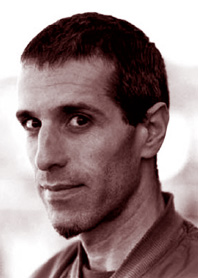
Eric
Drooker's paintings are seen on covers of The New Yorker, The Progressive,
The Village Voice and numerous other magazines, as well as books and
music albums (Rage Against The Machine, But Alive...., etc.) He is the
author of Flood! A Novel In Pictures, Illuminated Poems (with Allen
Ginsberg), Street Posters & Ballads, and Blood Song: A Silent Ballad.
He gives slide lectures at schools and cultural centers worldwide. Eric
is a third generation New Yorker, born and raised on Manhattan Island.
Eric's books:
Blood Song - A Silent Ballad *
Flood - A Novel In Pictures **
Illuminated Poems ***
Street Posters & Ballads ****
Drooker's
Illuminations
I first glimpsed Eric Drooker's odd name on posters pasted on fire-alarm
sides, construction walls checkered with advertisements & lamppost
junction boxes in the vortex of Lower East Side Avenues leading to Tompkins
Square Park, where radical social dislocation mixed homeless plastic tents
with Wigstock transvestite dress-up anniversaries, Rastas sitting on benches
sharing spliff, kids with purple Mowhawks, rings in their noses ears eyebrows
and bellybuttons, adorable or nasty skinheads, wives with dogs & husbands
used weekly for folk-grunge concerts, anti-war rallies, squatters' rights
protests, shelter for blanket-wrapped junkies & winos and political
thunder music by Missing Foundation, commune-rockers whose logo, an overturned
champagne glass with slogan "The Party's Over", was spray-painted
on sidewalks, apartments, brownstone and brick walled streets.
Eric
Drooker's numerous block-print-like posters announced much local action,
especially squatter's struggles and various mayoral-police attempts to
destroy the bandshell & close the Park at night, driving the homeless
into notoriously violence corrupted city shelters.
Tompkins Park had a long history of political protest going back before
Civil War anti-draft mob violence, memorialized as "....a mixed surf
of muffled sound, the atheist roar of riot" in Herman Melville's
The Housetop: A Night Piece (July 1983)
I began collecting Drooker's posters soon after overcoming shock, seeing in contemporary images the same dangerous class conflict I'd remembered from childhood, pre-Hitler block print wordless novels by Frans Masereel and Lynd Ward. Ward's images of the solitary artist dwarfed by the canyons of a Wall Street Megalopolis lay shadowed behind my own vision of Moloch. What "shocked" me in Drooker's scratchboard prints was his graphic illustration of economic crisis similar to Weimar-American 1930's Depressions.
In our own era, as one Wall Street stockbroker noted, "Reagan put the nation in hock to the military" with resulting collapse of human values & social stability. Drooker illuminated the widely-noted impoverishment of underclass, "diminishing expectations" of middleclass city dwellers, and transfer of disproportionate shares of common wealth to those already rich. This economic information, including facts of multi-billion savings & loan bankruptcies paid for by federal founds, was reported in neutral tones by newspapers of record but Drooker illustrated the city's infrastructural stress, housing decay, homelessness, garbage-hunger and bitter suffering of marginalized families, Blacks and youth, with such vivid detail that the authoritarian reality horror of our contemporary dog-eat-dog Malthusian technoeconomic class-war became immediately visible.
"....It is a question of genuine values, human worth, trustworthiness" Thomas Mann commented, introducing Frans Masereel's novel in woodcuts Passionate Journey. Drooker spent his childhood on East 14th Street & Avenue B, exploring the city early observing "shopping back ladies, stretch-cadillacs, screaming unshaven men, junkies nodding, Third Avenue prostitutes looking at themselves in rearview mirrors of parked cars." His maternal grandparents were 1930's socialists, his mother taught in the neighborhood's PS 19, on 11th Street & First Avenue, his father, white-collar computer programmer, tripped him to art museums all over the city.
1970's he attended Henry Street Settlement art classes, graduated from Cooper Union, moved permanently to East 10th Street close to Tompkins Park. Following family tradition he organized rent strikes, supported local squats and tenant oraganizing against police brutality. By 1980's working as freelance artist for many leftist groups, with reputation as radical street art-provocateur, he was arrested and thrown in District of Columbia jail for postering. In "denial" of economic crisis, city bureaucrats cracked down on Punk and political postering as a "public nuisance". Xeroxed flyers were considered "illegal graffiti".
By 1990's observant Op-end editors at The New York Times invited him to contribute art for their pages, as did The Nation, Village Voice and Newsweek. Under a new post-modern regime at The New Yorker, he published many illustrations, even covers, including a celebrated image of two bums huddled round a bright garbage-can fire as big snowflakes fell under the Brooklyn Bridge. His novel in pictures, Flood!, with its fantastic social dreams, won an American Book Award.
Our collaboration volume began as byproduct of an illustration of my poem The Lion For Real for his St. Mark's Poetry Project New Year's Day 1993 Benefit poster.
As i'd followed his work over a decade, I was flattered that so radical an artist of later generations found the body of my poetry still relevant, even ispiring. Our paths crossed often, we took part in various political rallies and poetical-musical entertainments.
a
biography by Allen Ginsberg,
December
28, 1995
